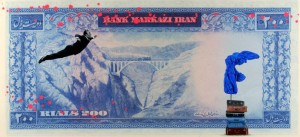Money on Wall

Statement for Behnam Kamrani’s exhibition at Aun Gallery, 24 Sep. to 17 Oct. 2010.
Someone gazing at a banknote is a wonderful scene. It happens not very often. S/he is looking at the contract itself. The banknote itself is complicit in this not-being-seen. It is also the fault of decoration. It is unimportant what the decoration is saying: instead of uttering ambiguous words, it mumbles so as to prevent another thing from being heard. The decoration of a column hides the pressure it tolerates, hides the stone and mortar.
A banknote with an artwork printed on it is inconceivable. Such a printed image should be too straightforward. Beneath it, it should be written, ‘The image of Damavand Mountain’. The arty aspect dissipates. It is too accessible. The image should be a collective, it cannot be unique. It needs to be Persepolis that cannot be moved, something national and general. The act of purchasing artworks shows the characteristic of banknotes: a collective is exchanged for what catches the eye. (I think of a world in which the image of Yves Klein jumping out of his dealer’s window is printed on banknotes.) People appropriate banknotes through similar additions: Sue loves Joe. Happy New Year 2002.
Andy Warhol loved money on the wall. ‘Say you were going to buy a $200,000 painting. I think you should take that money, tie it up and hang it on the wall. Then when someone visited you the first thing they would see is the money on the wall.’
According to him, only green bills are money. Right. Coins are precious in themselves. One can melt them down and make spoons and forks out of them. Yet, banknote is pure abstraction materialized: checks, IOUs, traveler’s checks and credit cards are only substitutes for banknotes and not as original. With her Zero Dollar banknotes, Laura Gilbert meant to show something different but showed that banknotes have a surplus. They are something more. And decoration fortifies this something more.
One who is gazing at a banknote is gazing at a strange object: at the most abstract and dynamic contract of the world, held up by politics and national cultures, a contract supervised by several organizations; it is the referent of economy that must be solidified and materialization of ‘value’ without any sophistication; everything can be translated to it while it remains silent itself; it is translatable to any language through the mediation of a moneychanger and all this is very inartistic.
Thus, the success of these artworks depends on the quality of the gaze at banknotes.